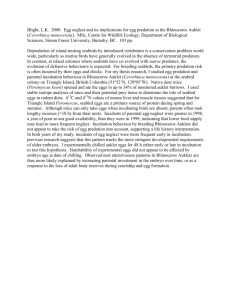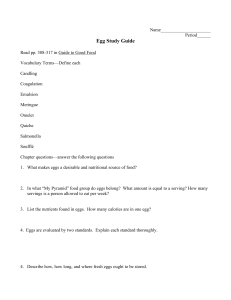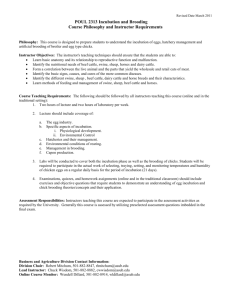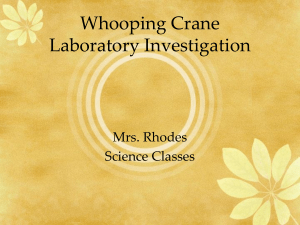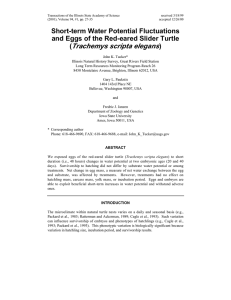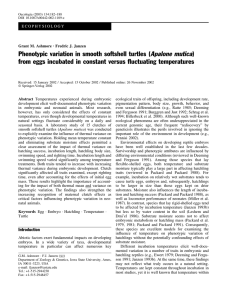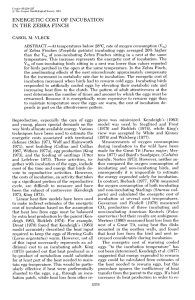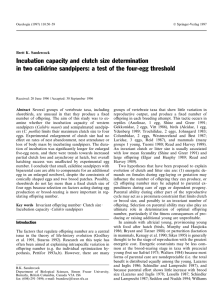(49) SOME CRITICISMS ON THE RECORDING OF INCUBATION
advertisement
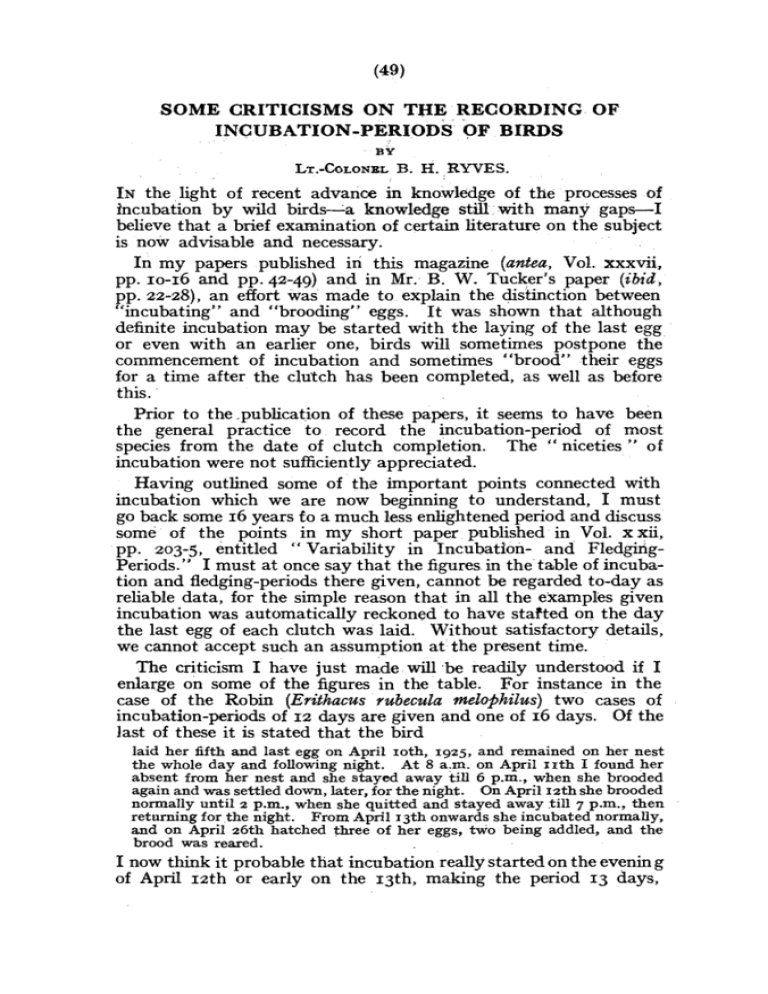
(49)
SOME CRITICISMS ON THE RECORDING OF
INCUBATION-PERIODS OF.BIRDS
BY
LT.-COLONSI. B. H. RYVES.
IN the light of recent advance in knowledge of the processes of
incubation by wild birds—a knowledge still with many gaps—I
believe that a brief examination of certain literature on the subject
is now advisable and necessary.
In my papers published in this magazine (antea, Vol. xxxvii,
pp. 10-16 and pp. 42-49) and in Mr. B. W. Tucker's paper (ibid,
pp. 22-28), an effort was made to explain the distinction between
"incubating" and "brooding" eggs. It was shown that although
definite incubation may be started with the laying of the last egg
or even with an earlier one, birds will sometimes postpone the
commencement of incubation and sometimes "brood" their eggs
for a time after the clutch has been completed, as well as before
this.
Prior to the .publication of these papers, it seems to have been
the general practice to record the incubation-period of most
species from the date of clutch completion. The " niceties " of
incubation were not sufficiently appreciated.
Having outlined some of the important points connected with
incubation which we are now beginning to understand, I must
go back some 16 years f 0 a much less enlightened period and discuss
some of the points in my short paper published in Vol. x xii,
pp. 203-5, entitled " Variability in Incubation- and FledgirigPeriods." I must at once say that the figures in the table of incubation and fledging-periods there given, cannot be regarded to-day as
reliable data, for the simple reason that in all the examples given
incubation was automatically reckoned to have staffed on the day
the last egg of each clutch was laid. Without satisfactory details,
we cannot accept such an assumption at the present time.
The criticism I have just made will be readily understood if I
enlarge on some of the figures in the table. For instance in the
case of the Robin (Eriihacus rubecula melophilus) two cases of
incubation-periods of 12 days are given and one of 16 days. Of the
last of these it is stated that the bird
laid her fifth and last egg on April 10th, 1925, and remained on her nest
the whole day and following night. At 8 a.m. on April n t h I found her
absent from her nest and she stayed away till 6 p.m., when she brooded
again and was settled down, later, for the night. On April 12th she brooded
normally until 2 p.m., when she quitted and stayed away till 7 p.m., then
returning for the night. From April 13th onwards she incubated normally,
and on April 26th hatched three of her eggs, two being addled, and the
brood was reared,
I now think it probable that incubation really started on the evening
of April 12th or early on the 13th, making the period 13 days,
50
BRITISH
BIRDS.
[VOL. XXXIX.
not 16. A protracted case of a similar type—also of a Robin—has
been described in Vol. xxxvii, p. 46.
Under Nuthatch {Sitta europma affinis) one incubation-period of
13 days and one of 17 days are recorded. As regards the second
case, though no details are given, I incline to the belief that there
may have been a period of "casual brooding" after the full clutch
was laid. If so, the period may well have been less than 17 days.
Four incubation-periods are recorded for broods of the HedgeSparrow {Prunella modularis occidentalis), two of 15 and two of
11 days. I now consider these figures almost valueless*. With
the two " fifteens" incubation may have commenced a day or two
after the last egg. With the two "elevens" it may have begun
with an egg prior to the last: in any case the fact of there having
been infertile eggs in both nests vitiates the figures as exact
records. Without close details being given such records should
not be accepted to-day.
The single CM Bunting (Emberiza c. cirhts) case recorded in
the paper presents a very difficult problem and affords clear proof
of the lack of our knowledge on a very important point—to what
extent does prolonged cooling of the eggs retard development
or actually cause fatality ?
The bird laid her second egg on May 16th and sat on them for the night.
On May 17th she deposited her third and last egg and began, apparently,
regular incubation. On May 19th she was absent for three hours and the
eggs became quite cold to the touch. On May 21st, at 4 p.m., I found the
eggs very cold, and when I went again at 8 p.m., though she was again absent,
the eggs were just warm. I did not visit the nest again until May 27th,
when the eggs were almost ice-cold to the touch, but I saw her, later on,
return to the nest. After this date I never found the eggs cold and on June
3rd, in the late afternoon, one egg was hatched, the nestling appearing to
be quite normal. Unfortunately the hen was killed that evening. Next
day the nestling was, of course, dead. I broke the two eggs and found one
to be addled, bnfrthe other contained a dead bird that I reckoned had been
ready to break shell within a few hours.
Here the nestling hatched 17 days after completion of the clutch,
in spite of the eggs having been'allowed to become very cold during
the prolonged absences of the female on several days after apparently
normal incubation had started. It may, however, be in order to
remark here that at that time I was not practised in the intensive
observation which later became a regular habit.
The following intensive observations of one pair of Cirl Buntings,
made in 1945, illustrate, I think, the great caution needed in
recording an apparently lengthy incubation-period. The pair made
two nestings, the details of which are :—•
* As records of incubation-periods, but valuable, of course, as records
of periods that may elapse between the completion of a clutch and the hatching
of the first chick.
VOL. x x x i x ]
INCUBATION-PERIODS OF BIRDS.
51
First Nest.
April 27th. First egg.
„ 29th.' Third and last egg. No brooding.
„ 30th. No brooding.
May 1st.
Incubation began and proceeded normally.
,, 15th. Two eggs hatched, the third infertile.
Period since clutch completed ... 16 days.
Incubation-Period
...
... 14 ,,
Second Nest.
June 5th.
„
8th.
First egg.
Fourth and last egg. Incubation began and
proceeded normally.
,, 22nd. Three eggs hatched, the fourth infertile.
Period since clutch completed ... 14 days.
Incubation-Period
14 ,,
As the Editor very rightly says .in. a letter to me, we do not
know at present how sustained sitting on eggs has to be for development to proceed, and, of course, I entirely agree with him, that an
investigation to settle the point will have to be undertaken sooner
or later—sooner, I hope. However, in my own experience, cases
of serious chilling of the eggs are very exceptional. The only
other example I .can recall, though a very much milder one than
that of the Cirl Bunting, has been described in Vol. xxxvii,
p. 47 (No. 3 Robin).
In conclusion, may I be allowed to repeat what I wrote in my
paper in Vol. xxii, already quoted?—"The main difficulty, as
it appears to me, is the question—when does incubation actually
begin ?
Does this change necessarily take place, with all
birds, soon after brooding is in process? Is it n o t possible that,
in some cases, the eggs may be covered for a time without producing
any definite change ? " I submit that these questions have only
been partially answered. Much work still lies ahead.

